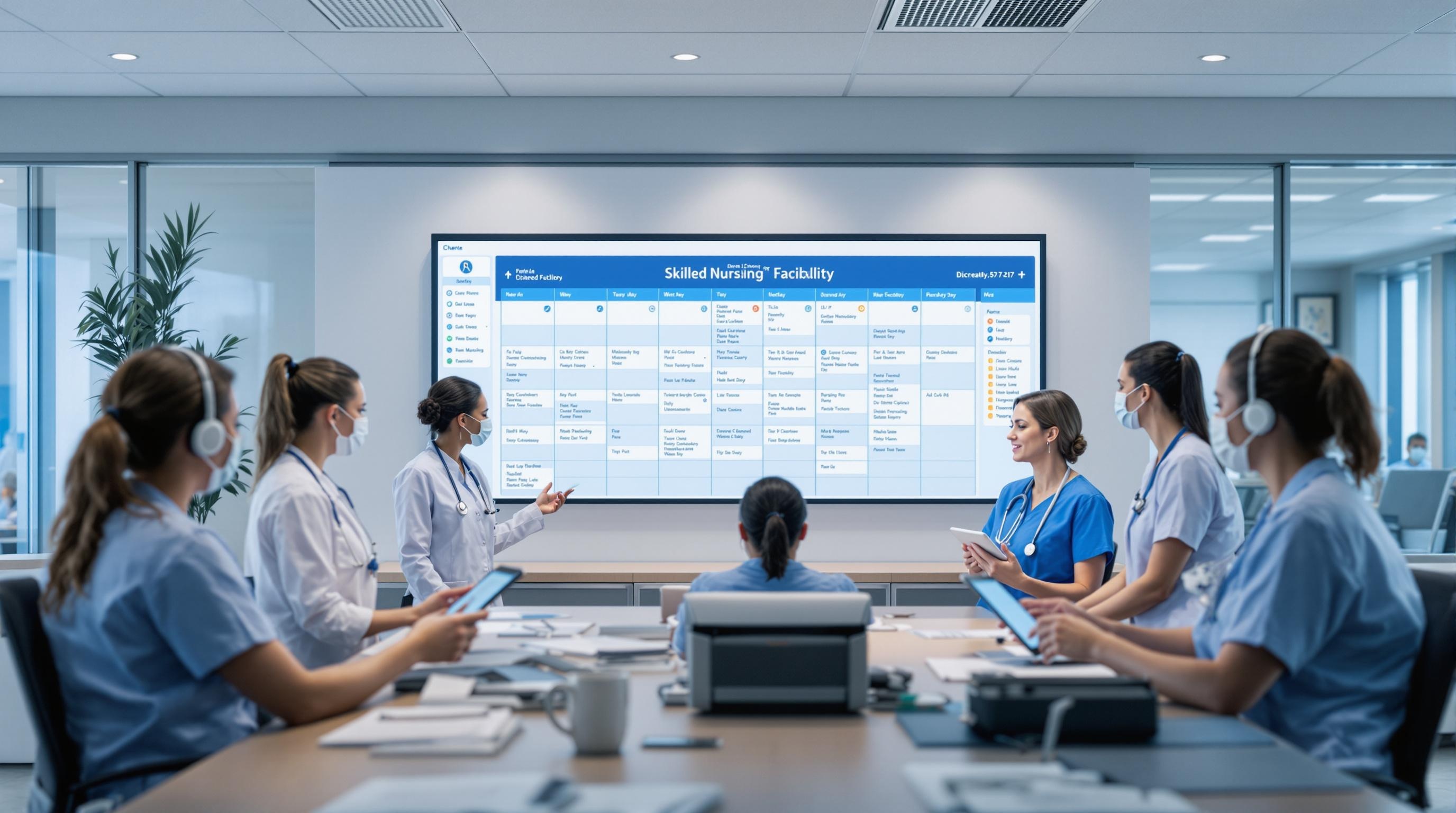Eliminate Manual Scheduling Errors in Skilled Nursing Facilities
Discover how skilled nursing facilities can eliminate manual scheduling errors, improve staff satisfaction, and ensure optimal care with smart solutions.
Quick Navigation
- 1. Introduction
- 2. Current Challenges in Eliminate Manual Scheduling Errors
- 3. How Sparkco AI Transforms Eliminate Manual Scheduling Errors
- 4. Measurable Benefits and ROI
- 5. Implementation Best Practices
- 6. Real-World Examples
- 7. The Future of Eliminate Manual Scheduling Errors
- 8. Conclusion & Call to Action
1. Introduction
Did you know that nearly 80% of skilled nursing facilities still rely on manual or spreadsheet-based scheduling methods? Despite the rapid pace of healthcare innovation, many organizations continue to juggle complex staffing needs with outdated tools—often resulting in costly mistakes, staffing shortages, and increased turnover. In a sector where every shift directly impacts resident care, even a single scheduling error can lead to gaps in coverage, compliance risks, and diminished staff morale.
Manual scheduling isn’t just a time-consuming administrative headache; it’s a potential threat to quality of care and operational stability. Paper-based processes and error-prone spreadsheets make it difficult for administrators to balance fluctuating census numbers, last-minute call-outs, and regulatory requirements. The result? Frustrated teams, overworked nurses, and missed opportunities to provide the best care possible. As staffing challenges continue to be a top concern for skilled nursing leaders nationwide, eliminating manual scheduling errors has never been more urgent—or more achievable.
In this article, we’ll explore the real impact of manual scheduling errors in skilled nursing facilities and how they affect everything from compliance to employee engagement. We’ll dive into the latest technology-driven solutions that are transforming scheduling into a strategic advantage, and share actionable steps your facility can take to reduce errors, boost staff satisfaction, and ensure residents always receive the care they deserve. If you’re ready to move beyond manual scheduling and future-proof your workforce, read on.
2. Current Challenges in Eliminate Manual Scheduling Errors
Scheduling staff in healthcare facilities, especially skilled nursing and long-term care, is a complex and critical process. Despite technological advances, many organizations still rely heavily on manual scheduling methods—often leading to costly errors and significant challenges. Eliminating manual scheduling errors is crucial for operational efficiency, regulatory compliance, and optimal patient care. Below are the primary pain points contributing to this ongoing issue:
-
1. Human Error and Data Entry Mistakes
Manual scheduling with spreadsheets or paper is inherently prone to mistakes. A 2021 study found that nearly 35% of healthcare scheduling errors are directly linked to manual data entry. Common errors include double-booking staff, missing shift assignments, and overlooking time-off requests, which can result in understaffed shifts or staff burnout. -
2. Difficulty Managing Compliance and Labor Laws
Healthcare facilities must navigate strict regulations regarding overtime, rest periods, and nurse-to-patient ratios. According to the American Hospital Association, 78% of compliance violations in healthcare are related to improper staffing documentation and scheduling irregularities. Manual systems make it difficult to track and enforce these requirements, increasing the risk of penalties and legal action. -
3. Lack of Real-Time Visibility
Manual schedules are often static and do not reflect real-time changes. This means last-minute call-outs or shift swaps can easily go unnoticed, leading to gaps in coverage. A 2022 Becker’s Hospital Review survey reported that 46% of healthcare leaders cite lack of real-time visibility as a top scheduling challenge. -
4. Inefficient Communication Among Staff
Communicating schedule changes through emails, calls, or posted paper schedules leads to confusion and missed updates. The Journal of Medical Systems notes that poor communication contributes to a 30% increase in scheduling conflicts and absenteeism. -
5. High Administrative Burden
Manual scheduling is time-consuming for managers, taking up to 20 hours per week in some facilities (ADP). This administrative overhead diverts valuable resources away from patient care and strategic initiatives. -
6. Difficulty Accommodating Staff Preferences
Manual systems make it challenging to honor staff preferences for shifts, leading to dissatisfaction and higher turnover. According to the American Nurses Association, 58% of nurses report schedule dissatisfaction as a key factor in burnout and attrition. -
7. Inconsistent Patient Coverage
Scheduling errors can directly impact patient care. Inadequate or unbalanced staffing results in longer wait times, reduced patient satisfaction, and increased risk for adverse events. A PSNet report highlights that patient safety incidents are 20% more likely to occur during understaffed shifts.
These challenges demonstrate that manual scheduling not only hampers operational efficiency and compliance but also threatens the quality and safety of patient care. Transitioning to automated, intelligent scheduling solutions is essential for healthcare facilities aiming to reduce errors, improve staff satisfaction, and deliver superior patient outcomes.
3. How Sparkco AI Transforms Eliminate Manual Scheduling Errors
Manual scheduling errors have long plagued skilled nursing facilities, leading to understaffing, shift overlaps, non-compliance with labor laws, and increased administrative workload. Traditional spreadsheet-based or paper scheduling processes are not only time-consuming but also highly prone to human error, resulting in potential disruptions to patient care and staff satisfaction. Sparkco AI revolutionizes this critical function by automating and optimizing employee scheduling with the power of artificial intelligence, virtually eliminating manual scheduling mistakes.
- Intelligent Shift Matching: Sparkco AI uses advanced algorithms to automatically assign the right staff to the right shifts, based on credentials, availability, preferences, and legal requirements. This prevents double-booking, missed shifts, and ensures that every shift is covered by appropriately qualified personnel.
- Real-Time Error Detection: The system continuously monitors schedule changes and immediately flags conflicts, such as overlapping shifts or insufficient rest periods. This instant feedback allows scheduling managers to address issues before they become costly mistakes.
- Automated Compliance Checks: Sparkco AI is programmed to recognize and enforce complex labor laws, union rules, and facility-specific policies. By automating compliance, the risk of unintentional violations and the associated penalties is dramatically reduced.
- Self-Service Scheduling and Staff Input: Caregivers can request shifts, swap assignments, or update their availability via a user-friendly mobile interface. By empowering staff to participate in the scheduling process, Sparkco AI minimizes communication errors and ensures the schedule reflects real-time staff input.
- Predictive Analytics for Staffing Needs: Leveraging historical data and AI-driven forecasting, Sparkco AI predicts future staffing demands based on census trends, seasonal fluctuations, and anticipated absences. This proactive approach further minimizes scheduling gaps and last-minute scrambles.
- Seamless Integration with Existing Systems: Sparkco AI integrates effortlessly with electronic health records (EHR), payroll, timekeeping, and human resources platforms. This connectivity ensures that all staff data is current and eliminates the risk of mismatched information across systems.
By automating scheduling with Sparkco AI, skilled nursing facilities dramatically reduce the administrative burden on managers and eliminate the most common manual errors. The system’s AI-driven logic ensures that every shift is accurately filled, every compliance rule is met, and staff preferences are honored—all in a fraction of the time it takes with traditional methods. Real-time error detection and predictive analytics further ensure that scheduling is both responsive and resilient to the ever-changing needs of healthcare environments.
Sparkco AI’s integration capabilities allow for smooth data flow between scheduling, HR, EHR, and payroll systems, removing data silos and reducing re-entry mistakes. The result is a more efficient, compliant, and satisfied workforce—supporting better patient care and operational excellence.
4. Measurable Benefits and ROI
Manual scheduling in skilled nursing facilities (SNFs) is not only time-consuming but also prone to costly errors that impact staffing, compliance, and operational efficiency. Leveraging automated scheduling systems delivers measurable, data-driven benefits—streamlining workflows, reducing costs, and boosting staff satisfaction. Below are key benefits, supported by industry data:
- Significant Cost Savings: Facilities adopting automated scheduling solutions have reported annual savings of over $65,000 per department. According to the OnCall ROI handout, this figure was based on a department with approximately 55 staff members and 18 beds. These savings stem from reduced overtime, lower administrative costs, and avoidance of regulatory penalties.
- Reduction in Scheduling Errors: Automated systems can reduce manual scheduling errors by up to 75%. Fewer errors mean less risk of understaffing, overstaffing, or non-compliance with labor laws.
- Time Savings for Managers: Scheduling managers can reclaim up to 80% of the time previously spent on manual roster creation and shift adjustments. Tasks that once took hours each week can now be completed in minutes, allowing leaders to focus on resident care and staff engagement.
- Improved Compliance and Reporting: Automated scheduling helps ensure adherence to federal and state staffing regulations. By providing real-time documentation and alerts, these systems help decrease compliance-related incidents—potentially reducing deficiency citations by up to 20%.
- Enhanced Staff Satisfaction and Retention: With fewer scheduling conflicts and improved shift transparency, staff satisfaction rates rise. Facilities using automation report a decrease in turnover rates by 10-15%, which further lowers recruitment and training expenses.
- Lower Overtime and Agency Costs: Automated scheduling optimizes shift assignments, reducing unnecessary overtime and expensive agency staffing by up to 30%. This leads to more predictable payroll and budget management.
- Better Shift Coverage: Automation ensures that every shift is filled according to skill mix and regulatory requirements, resulting in up to 99% shift coverage and enhanced resident safety.
- Data-Driven Decision Making: Real-time analytics empower administrators to identify patterns, forecast staffing needs, and make informed adjustments, contributing to ongoing operational improvements.
For more details and real-world outcomes, explore the full OnCall ROI handout, which provides department-level insights into the transformative impact of automated scheduling in healthcare environments.
5. Implementation Best Practices
Transitioning away from manual scheduling is essential for compliance with new CMS standards on appointment wait times and for improving operational efficiency. Follow these best practices to successfully eliminate manual scheduling errors in your skilled nursing facility.
-
Conduct a Comprehensive Workflow Assessment
Map your current scheduling process to identify where errors most frequently occur. Engage staff from all shifts to capture real-world challenges.
Tip: Use anonymous surveys or interviews to uncover hidden bottlenecks.
Pitfall to Avoid: Overlooking input from frontline staff, who are closest to the process. -
Select an Appropriate Scheduling Solution
Choose a digital platform that integrates with your EHR and meets CMS compliance requirements. Prioritize solutions offering automated conflict detection and real-time updates.
Tip: Request demos and trial periods before committing.
Pitfall to Avoid: Selecting a system based solely on cost rather than feature alignment. -
Engage Stakeholders Early
Involve nursing staff, schedulers, IT, and leadership in the decision-making process to foster buy-in.
Tip: Hold kickoff meetings to gather concerns and suggestions.
Pitfall to Avoid: Imposing change without stakeholder input, which can lead to resistance. -
Develop Standardized Scheduling Protocols
Create clear guidelines for appointment booking, shift swaps, and time-off requests that align with CMS requirements.
Tip: Document protocols and make them easily accessible to all staff.
Pitfall to Avoid: Allowing ad-hoc workarounds that undermine standardization. -
Provide Comprehensive Training
Offer hands-on training sessions and refresher courses for all users to ensure confident adoption.
Tip: Use real-life scenarios in training to reinforce learning.
Pitfall to Avoid: Assuming brief or one-time training is sufficient. -
Monitor and Review Scheduling Data
Regularly audit schedules for compliance with CMS wait time standards and to identify recurring issues.
Tip: Set up automated alerts for scheduling conflicts or missed appointments.
Pitfall to Avoid: Neglecting ongoing performance monitoring post-implementation. -
Foster a Culture of Continuous Improvement
Encourage open feedback from staff and adjust protocols as needed to enhance efficiency and satisfaction.
Tip: Hold quarterly reviews and reward teams for error reduction.
Pitfall to Avoid: Ignoring feedback, which can stall long-term adoption. -
Communicate Benefits and Progress
Keep staff informed about how digital scheduling reduces errors, enhances care quality, and supports regulatory compliance.
Tip: Share success stories and metrics in staff meetings and newsletters.
Pitfall to Avoid: Failing to highlight wins, leading to disengagement.
Change Management Considerations: Successful scheduling automation depends on transparency, ongoing support, and leadership engagement. Address concerns proactively, provide ample training, and celebrate milestones to build enthusiasm for the new process.
6. Real-World Examples
Real-World Examples: Eliminating Manual Scheduling Errors in Skilled Nursing Facilities
Manual staff scheduling in skilled nursing facilities (SNFs) often leads to errors such as double-bookings, shift gaps, and compliance risks. These mistakes impact patient care, staff satisfaction, and facility finances. Here’s an anonymized case study illustrating how transitioning to automated scheduling software can transform operations:
-
Situation:
- A 120-bed SNF in the Midwest was using paper schedules and spreadsheets to manage over 70 nursing staff. Frequent manual errors resulted in accidental overtime, last-minute shift changes, and non-compliance with state-mandated staffing ratios. Staff dissatisfaction was high, with a turnover rate of 28% and overtime costs averaging $12,000/month.
-
Solution:
- The facility implemented an automated scheduling platform designed for SNFs. The system integrated with their payroll and HR software, automatically










